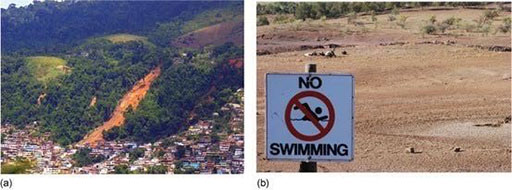4.3 Humans – extreme weather
Humans are affected by climate change too, and particularly by changes to extreme weather and extreme sea level. We are adapted to our local climate and sea level, so these changes push at the boundaries of our resilience.
Activity 5 Extreme weather events
Use the box below to record as many types of extreme weather events as you can think of:
Answer
Extreme weather events can include heatwaves, storms, forest fires, floods and droughts.
How do these extreme weather events impact on humans?
Answer
These events affect every part of the planet and every part of human life: agriculture, transport, power, housing, the environment and, of course, human health. The direct impacts on human health include physical injury, dehydration, malnutrition, heat stroke, water-borne diseases, malaria and famine.
Two examples of direct impacts, in Brazil and South Australia, are shown in Figure 15.

Extreme weather events also have indirect impacts. These might be, for example, reduced agricultural yields and social instability such as violent crime and mass migration (Edwards and Challenor, 2013; Watts et al., 2015).
Whether the impact is direct or indirect, the intensity of the impact is also governed by how exposed and vulnerable the human population is. So, contributing factors to impact intensity are:
- The hazard: i.e. the intensity and frequency of extremes.
- Exposure: for example, only coastal areas are exposed to sea level rises.
- Vulnerability: for example, more developed countries generally have more resilient transport and energy systems, buildings and agriculture than do less developed countries. They are also more likely to have systems for reducing health impacts, such as medical infrastructure, warning systems and air conditioning.
An increase in the impacts of extreme weather may be due to increases in the frequency and severity of extreme weather events, or due to increases in exposure and vulnerability.
One important example of an impact of extreme weather is financial losses. Financial losses from extreme weather events have risen during the twentieth century. This is thought to be largely due to increases in exposure and vulnerability.
